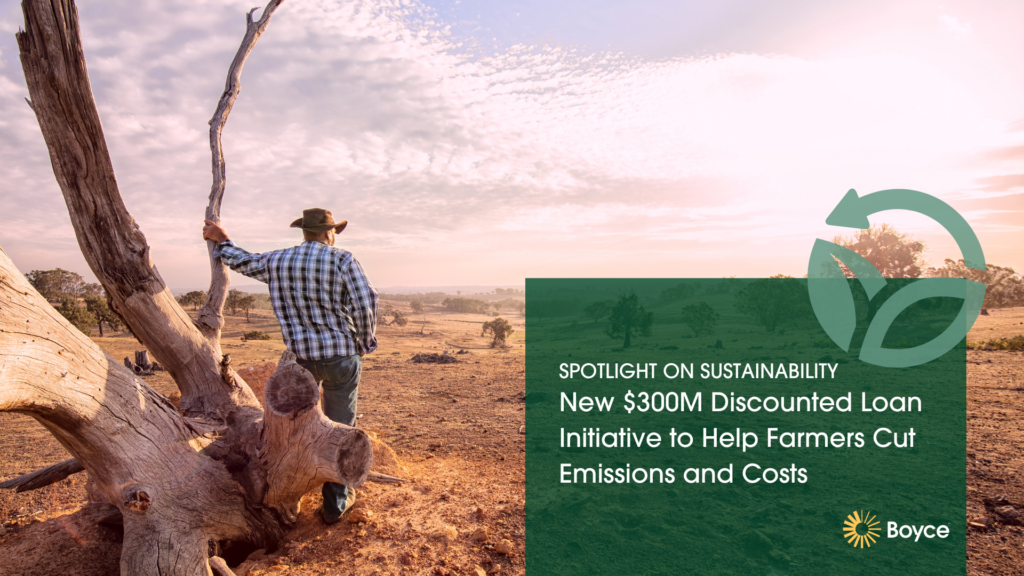

Australian farmers now have access to a new $300 million government-backed ‘Emissions Reduction Incentive product’ designed to help reduce on-farm emissions while also cutting operational costs. Announced by the Clean Energy Finance Corporation (CEFC), this program offers discounted loans with interest rate reductions of up to 1.15% for farmers, agribusinesses, and equipment purchasers who invest in sustainable, low-emission technologies. Loans from the program will range between $1 million and $5 million, resulting in a potential savings of more than $57,000 a year in borrowing costs for farmers when they invest in technologies and practices that will deliver environmental and financial benefits.
By making these upgrades, farmers can lower their reliance on fossil fuels, improve soil health, and increase productivity—all while saving money.
Delivered in partnership with NAB, the initiative aims to make it easier for agribusinesses to adopt climate-smart practices without a significant financial burden. This initiative has followed Rabobank’s announcement to offer concessional loans to landowners specifically for covering the upfront cost of planting native trees to attract carbon credits.
 Understanding What’s Eligible
Understanding What’s EligibleThe $300m initiative will be accessible via two tailored programs: a $200m vehicle and equipment package and a $100m package to reduce on-farm carbon footprints. Farmers looking to take advantage of the program will need to demonstrate that their investment leads to measurable emissions reductions.
Eligible purchases include:
By making these upgrades, farmers can lower their reliance on fossil fuels, improve soil health, and increase productivity—all while saving money.
 Steps to Access the Loan
Steps to Access the LoanTo access the loan, farmers must first assess their eligibility by identifying potential upgrades that align with the CEFC's emissions-reduction criteria. They then need to submit a well-structured plan to the bank, that outlines their emissions reduction strategy and a cost and benefits analysis. There are various loan options available to farmers, which you can discuss with your bank’s program financial partner.
Once approved, loan recipients can implement their sustainability initiatives and begin tracking their impact. By integrating low-emission technologies into their operations, farmers not only future-proof their businesses against tightening environmental regulations but also strengthen their competitiveness in markets that increasingly prioritise sustainability.
 How can Boyce help
How can Boyce helpUnderstanding which investments will deliver the greatest financial and environmental benefits can be complex. Boyce Sustainability partners with farmers to turn this opportunity into real financial and environmental gains, ensuring investments are both practical and profitable.
Boyce Sustainability can assist farmers in:
 Our expertise
Our expertiseWe work closely with our clients to ensure their sustainability investments are not only eligible for funding but also deliver measurable business value. By integrating financial expertise with sustainability insights, we help farmers maximise the benefits of this opportunity—ensuring that cost savings, productivity gains, and environmental impact are all optimised.
 Positioning Farms for Long-Term Profitability & Sustainability
Positioning Farms for Long-Term Profitability & SustainabilityThis initiative signals a significant step in supporting Australian agriculture’s transition to lower emissions while maintaining productivity and profitability. With rising input costs and increasing consumer demand for sustainable products, the program offers a timely opportunity for farmers to make meaningful changes that benefit both their businesses and the environment.
By leveraging expert guidance and financial support, farmers can ensure their businesses remain competitive, resilient, and future-ready.
Boyce Sustainability is here to guide you through the process—helping you make the right investment decisions and ensuring you unlock the full potential of this initiative.
Written by Tim Donovan and Lily Cochrane.
For more information contact us:

Tim Donovan - Executive Business Unit Leader
(02) 6883 1289

Lily Cochrane - Sustainability Manager
(02) 6450 3225
Backing farmers, high quality carbon credits and positive environmental outcomes